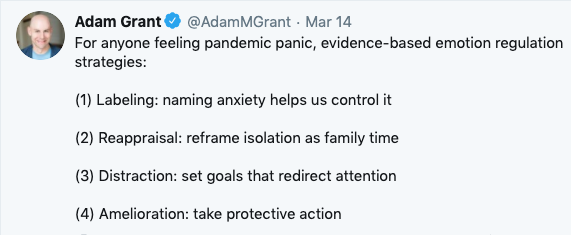How Feeling Identification Can Help Managers Become Impactful Coaches
In moments of extreme happiness or sadness, how easy is it for you to match words to your emotions? Are you able to precisely describe what it is you’re truly feeling?
This exercise is called feeling identification. The ability to name your feeling is not something that can be mastered effortlessly, but rather, it’s a lifelong practice that can contribute to building resilience for whatever life throws your way. Not only does feeling identification help you take stock of your emotions, but it allows you to control how you show up each day.
According to positive psychology research, in order to transform from a state of surviving to thriving, it takes resilience, i.e., the ability to navigate adversity and bounce back in the face of challenge. Resilience can lead to positive changes after a crisis. Luckily, resilience is a skill that can be developed by both individuals and organizations.

Building resilience by understanding emotions
Research shows feeling identification leads to healthier relationships and greater wellbeing, and better resilience. Naming specific emotions helps loosen its grip, take back control, and normalize your feeling—something that is especially important during inevitable moments of stress. This is a skill similar to learning a new language and requires practice.
“Letting emotions in doesn’t give them power over us. It gives them room to move through us,” says Adam Grant, organizational psychologist at Wharton School of the University of Pennsylvania.
Use granular feeling identification to become a better coach
Emotional granularity, which is the ability to make fine-grained distinctions between similar emotions, can help you better safeguard against the harmful impact of negative feelings and strengthen the effects of positive emotions.
Understanding the difference between feeling sad and happy is relatively easy. However, the ability to distinguish between two comparable emotions, such as angry versus annoyed, or discouraged versus hopeless, requires greater skill and self-awareness.
Research shows emotional granularity also increases the ability to understand other people’s emotions accurately, which can help people successfully navigate complex environments, such as the workplace.
For managers, identifying the emotions of your employees, and especially remote employees, can be difficult. Honing your ability to identify your own emotions can carry over to help you recognize the emotions of your employees.
For example, if you notice one of your direct reports is anxious, don’t jump to conclusions that there is an issue at work. What’s affecting them could just as easily be something brought from home, especially with the added stress of the pandemic, so make sure you aren’t limiting your conversation strictly to business. Plus, conversations beyond work are how trust is formed and bonds are strengthened.
Regulating emotions during a pandemic
Identifying your emotions can help you develop the ability to control and regulate emotions, and coaching your remote employees to do the same can help build a more positive and collaborative work environment.
Adam Grant along with Brene Brown, a research professor at the University of Houston, promote the following emotion-regulation strategies as people around the globe are feeling the impact of COVID-19.

Taking these steps while also learning how to coach your people through them can help enhance resilience. But identifying emotions, especially ones that are negative, is only half of the equation. Once a negative emotion has been named, there should be action taken to improve the situation in order to regain the feeling of control and to reduce the feeling of helplessness.
Pro tip: During 1-on-1 meetings with your employees, don’t forget to share your feelings as well. Research by Harvard Business School professor Jeff Polzer shows the process of building trust starts with vulnerability. Sharing your emotions with employees can help create a safe environment for your people to be open and honest.
What emotions are you feeling?
There are thousands of emotions that a person can experience, and identifying which one you’re feeling in a particular moment can be overwhelming. Below is a helpful example for identifying feelings with emojis, which can help promote self-awareness and emotional intelligence through granular feeling identification.
Additional resources:
• Feeling Words chart by School Transformation
• Ekmans Atlas of Emotions (commissioned by the Dali Lama)

Courtney Bigony is the Director of People Science at 15Five, industry leading people management software, where she developed Positive Product Design which aligns the product to the latest science of thriving. Courtney has a Masters of Applied Positive Psychology from the University of Pennsylvania, is the founder of The Deep Feedback Movement, and a Fellow at the Center for Evidence Based Management. She was named a 2019 Workforce Game Changer by Workforce Magazine, and has contributed pieces featured in Forbes and Huffington Post. Follow her on twitter @CourtneyBigony.




